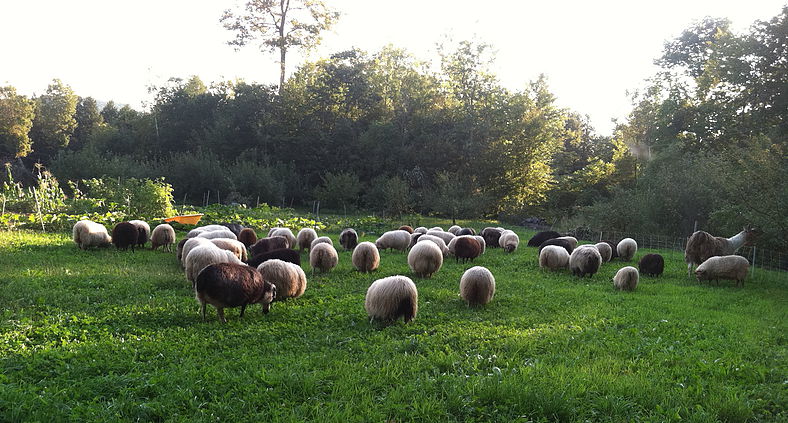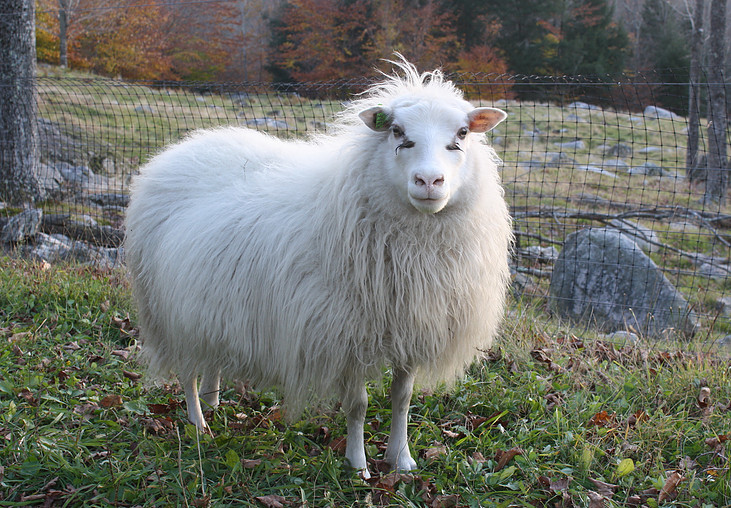The Healthy Flock
Here at Frelsi Farm we innoculate our sheep against rabies, they get an annual CDT (Clostridial Disease and Tetanus), they are OPP (Ovine Progressive Pneumonia) tested each year. We deworm our sheep on a regular basis. Our lambs get an injection of Selenium when they’re born. We are enrolled in the VSFCP (Voluntary Scrapie Flock Certification Program). And our sheep are foot rot free.
Which, if you’re new to this, is absolute Greek.
Keeping your sheep healthy is multi-step approach which starts with the basics: don’t let them get sick in the first place. And the easiest method is Prevention. Prevention means Bio-Security.
Bio-Security means we’re more than a little obsessed with cleanliness. We don’t allow visitors into the areas where the sheep are until they’ve disinfected their boots or shoes (so if you visit, please bring rubber boots!). When we bring a sheep to a show, we don’t bring it home, because we are what is called a “closed flock.” To achieve genetic diversity, we use AI (artificial insemination).
So, from where we’re sitting, step one to healthy sheep is to practice good sanitation.

Step two is to provide them with the feed and minerals they need to keep themselves healthy. Your local agricultural agency will be able to help you formulate a salt/mineral blend appropriate for your sheep. No matter what your feed store tells you… you do NOT want to get solid block salt for you Icelandic Sheep. Loose salt/minerals is much better, and doesn’t risk chipping a tooth!
We also free feed our sheep Kelp blended with Selenium because it doesn’t exist in our soil, and Vitamin E. We maintain a hopper for salt and a hopper for kelp. Other farms maintain one hopper, putting kelp on one side and salt on the other. Kelp isn’t strictly necessary, but we feel the sheep do better when they have access to it.
 Icelandic Sheep eat hay, and grass. The hay should be leafy green… alfalfa hay is wonderful, but not necessary. You should never feed moldy hay to sheep. You can feed in round bales if you have the equipment to handle the bales…but whatever you decide to do, you’ll need a reliable source of hay. Or two unreliable sources. You can have your hay tested for feed value if you like, 16% protein is pretty good grass hay. If your hay tests to around 8% you’ll want to supplement the hay with a little grain or alfalfa pellets, or even soy meal, which is a great source of protein.
Icelandic Sheep eat hay, and grass. The hay should be leafy green… alfalfa hay is wonderful, but not necessary. You should never feed moldy hay to sheep. You can feed in round bales if you have the equipment to handle the bales…but whatever you decide to do, you’ll need a reliable source of hay. Or two unreliable sources. You can have your hay tested for feed value if you like, 16% protein is pretty good grass hay. If your hay tests to around 8% you’ll want to supplement the hay with a little grain or alfalfa pellets, or even soy meal, which is a great source of protein.
Icelandic sheep don’t require the high protein diets of other meat breeds… so you don’t have to feed the same volume of grains to a Icelandic as you would another breed, making the Icelandic a “thrifty” breed. They thrive on grass. But even if your sheep are positively thriving on grass, water, and their salt/mineral supplement, putting on weight and dancing with health, you might want to feed them a little handful of grain every few days anyway. Our sheep have been bred not only for their health and other physical characteristics, but for their temperaments as well. And a handful of grain will bring them flocking around you for skritches and general bonding. And they’ll start associating you and the bucket with All Things Good! Which, can be very helpful.
 You’ll also need a supply of fresh clean water. Sheep need a regular source of clean water. Icelandic sheep want to drink a gallon of water a day when they’re pregnant, more when they’re nursing, and in the hot months of the summer, they’ll need to replace volumes of water. Please don’t underestimate the importance of having fresh water for your sheep… but you don’t want to rely on a farm pond unless you’re willing to watch the sides of the pond deteriorate. And the sheep will contaminate the pond. You’ll find a trough system, or even buckets filled regularly, preferable to the pond.
You’ll also need a supply of fresh clean water. Sheep need a regular source of clean water. Icelandic sheep want to drink a gallon of water a day when they’re pregnant, more when they’re nursing, and in the hot months of the summer, they’ll need to replace volumes of water. Please don’t underestimate the importance of having fresh water for your sheep… but you don’t want to rely on a farm pond unless you’re willing to watch the sides of the pond deteriorate. And the sheep will contaminate the pond. You’ll find a trough system, or even buckets filled regularly, preferable to the pond.
Before your sheep arrive, you’ll want to have an area securely fenced for them. You can use either woven mesh, or electrified fencing, depending on your situation. You’ll also need to provide a shelter from the winter wind, and a shelter they can use in the summer to get out of the sun. We use very flexible hoop houses which are surprisingly inexpensive to build and maintain for our Icelandic sheep. Many people like to build a small barn, but the truth is that there are less expensive alternatives, and we suspect the barn is more for the comfort of the shepherd than the sheep!
Sheep pick up parasites, and all sheep need to be wormed. There are many schools of thought on wormers and how to use them and what works on our farm may not work on yours. You may be more comfortable talking with your local vet and taking fecal samples in for testing than simply trying the hit or miss approach. You want to worm as often as necessary… but not when unnecessary, because the worms will build up a tolerance for the wormers. However, every shepherd should check their sheep’s eyelids and gums to make sure they are a healthy pink. If they are not, treating the sheep promptly for worms is probably in order.

You’ll also need to check and trim you sheep’s feet regularly, lest the nail grow out and curl under, making walking difficult and picking up foreign matter and packing it into the foot. Trimming hooves for the first time is probably easier with two people, one holding and the other trimming. Have your partner lift the sheep up, then sit down on a bucket with the sheep set down on its rump. Put one foot down on the floor between the sheep’s rear feet. Now you’ve got the sheep nice and securely. He may wiggle and struggle, but he’s not going anywhere, and you can concentrate on trimming the feet. Trim them so they’re nice and flat, taking off the excess nail on each side, off the tip if necessary, and off the heel if necessary. Praise the sheep and let it go!
A couple of years ago one of our new farms announced that all they really wanted was The List. The List of Supplies to Have On Hand, or the First Aide Kit List, or the List of Lambing Supplies… oh and the list of Spinning Mills too! We’re working on the list. The fact is, that while you’d think you’d be able to get your supplies all from one handy source, you’ll discover you can’t. And one of the extreme frustrations is trying to track down the things you need across multiple suppliers. I won’t lie to you, getting into sheep can be dauntingly expensive if you’re buying all your supplies in one blow, especially since very few of these places package things for small farms. And medications can add up, so you’ll want to buy prudently. We suggest you talk to your local large animal vet, even if you intend to do all your own work, to see if they’ll sell you what you need in smaller quantities. You’ll pay more per dose, but you won’t have to worry about expiration dates on a large bottle.
![]()

